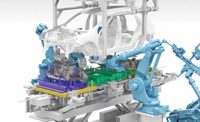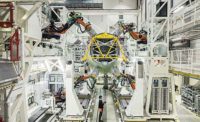1 // FORD TESTING BIPEDAL ROBOTS FOR PACKAGE DELIVERY
Ford Motor Co. has begun testing a human-like robot, called Digit, with two arms and two legs for loading and unloading delivery vans. Created by Agility Robotics, Digit is designed to walk upright and can traverse the same environments most people do every day. Digit can also fold itself up for easy storage in the back of a vehicle. Once the vehicle arrives at its destination, Digit can be deployed to grab a package and carry out the final step in the delivery process.
If the robot encounters an unexpected obstacle, it can send an image back to the vehicle to leverage additional computing power. The vehicle could even send that information into the cloud and request help from other systems to enable Digit to navigate.
2 // B&R INTEGRATES ABB ROBOTS
B&R, a unit of ABB’s Robotics and Discrete Automation business, has integrated ABB robots into its automation portfolio. As a result, machine builders can buy robots from B&R along with their control, I/O and drive components. Engineers will benefit from synchronization between the robots and controls. Since the robots will no longer require a dedicated controller, all interfaces between the machine and the robot are eliminated. And, because all axes and sensors will communicate on a common network, precision and response time will increase.
3 // FANUC INTRODUCES NEW COBOTS
FANUC has introduced a pair of new cobots: the CRX-10iA, with a maximum reach of 1,249 millimeters, and the CRX-10iA/L, with a maximum reach of 1,418 millimeters. Both can carry a maximum payload of 10 kilograms. Sensitive contact detection allows the robots to work safely alongside people. The robot is simple to program and easily connects with third-party grippers.
4 // SIEMENS CNC CONTROL FOR COMAU ROBOTS
The Sinumerik CNC control system from Siemens can now be used to program and control Comau six-axis robots directly, without the need for a separate robot controller. Integrating control of the robot arm into the CNC helps improve path and positioning accuracy, as well as reliability. It also enhances dynamic response during robot-aided machining tasks. As a result, the robot can undertake more challenging applications, such as additive manufacturing, fiber placement, metal cutting and laser machining.
5 // 300,000
More than 300,000 robots are now operating in South Korea, according to the International Federation of Robotics. The number of robots in the country has doubled in the past five years. Only Japan and China have more.










